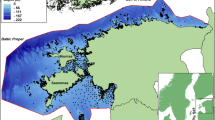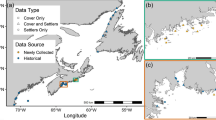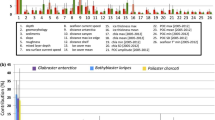Abstract
There is an increasing demand for biodiversity mapping to address new challenges in the management of marine ecosystems. Species distribution models are a key tool in supplying part of this information. However, the use of these models in the marine environment is still developing and the reasons for the underlying use of different methodological approaches are not always clear. In this work, we compared four different statistical techniques: the ecological niche factor analysis (ENFA), the MAXimun ENTropy algorithm (MAXENT), general additive Models (GAMs), and Random Forest. ENFA and MAXENT were applied using presence-only data whereas GAM and Random Forest used presence–absence data. As a case study, we used four deep sea urchin species: Centrostephanus longispinus, Coelopleurus floridanus, Stylocidaris affinis, and Cidaris cidaris. The distribution of the studied sea urchins showed strong bathymetric segregation. Depth was the most important variable, followed by reflectivity and slope. The correlations between the predictive outputs of the models were similar between GAM, Random Forest and MAXENT, and lower for ENFA. Models using presence/absence data showed the highest scores in the four species, significantly outperforming ENFA in most of the cases, although differences with MAXENT were significant in only one species.






Similar content being viewed by others
References
Akaike, H., 1973. Maximum likelihood identification of Gaussian autoregressive moving average models. Biometrika 60: 255–265.
Anderson, M. J., 2001. A new method for non-parametric multivariate analysis of variance. Austral Ecology 26: 32–46.
Bedia, J., J. Busquet & J. Gutierrez, 2011. Predicting plant species distribution across an alpine rangeland in northern Spain. A comparison of probabilistic methods. Applied Vegetation Science 14: 415–432.
Borja, Á., M. Elliott, J. Carstensen, A. S. Heiskanen & W. van de Bund, 2010. Marine management – towards an integrated implementation of the European Marine Strategy Framework and the Water Framework Directives. Marine Pollution Bulletin 60: 2175–2186.
Breiman, L., 2001. Random forests. Machine Learning 45: 5–32.
Brotons, L., W. Thuiller, M. B. Araújo & A. H. Hirzel, 2004. Presence-absence versus presence-only modelling methods for predicting bird habitat suitability. Ecography 27: 437–448.
Bryan, T. L. & A. Metaxas, 2007. Predicting suitable habitat for deep-water gorgonian corals on the Atlantic and Pacific Continental Margins of North America. Marine Ecology Progress Series 330: 113–126.
Byrne, M., M. A. Ho, L. Koleits, C. Price, C. K. King, P. Virtue, B. Tilbrook & M. Lamare, 2013. Vulnerability of the calcifying larval stage of the Antarctic sea urchin Sterechinus neumayeri to near-future ocean acidification and warming. Global Change Biology 19: 2264–2275.
Calenge, C., 2006. The package “adehabitat” for the R software: a tool for the analysis of space and habitat use by animals. Ecological Modelling 197: 516–519.
Cohen, J., 1960. A coefficient of agreement for nominal scales. Educational and Psychological Measurement 20: 37–46.
Cranmer, G. J., 1985. Recent investigations into the distribution of regular echinoids in the North-Sea. Journal of the Marine Biological Association of the UK 65: 351–357.
Dañobeitia, J. J. & B. J. Collette, 1989. Estudio mediante sísmica de reflexión de un grupo de estructuras submarinas situadas al Norte y Sur del archipiélago Canario. Acta Geológica Hispánica 24: 147–163.
Darr, A., M. Gogina & M. L. Zettler, 2014. Detecting hot-spots of bivalve biomass in the south-western Baltic Sea. Journal of Marine Systems 134: 69–80.
Dorazio, R. M., 2012. Predicting the geographic distribution of a species from presence-only data subject to detection errors. Biometrics 68: 1303–1312.
Elith, J. & C. H. Graham, 2009. Do they? How do they? Why do they differ? On finding reasons for differing performance of species distribution models. Ecography 32: 66–77.
Elith, J., S. J. Phillips, T. Hastie, M. Dudik, Y. E. Chee & C. J. Yates, 2011. A statistical explanation of MaxEnt for ecologists. Diversity and Distribution 17: 43–57.
Fernández-Palacios, J. M., 2004. Introducción a las islas. In Fernández-Palacios, J. M. & C. Morici (eds), Ecología Insular/Island Ecology. AEET/Cabildo Insular de La Palma, La Palma: 21–55.
Fielding, A. & J. Bell, 1997. A review of methods for the assessment of prediction errors in conservation presence-absence models. Environmental Conservation 24: 38–49.
Fraschetti, S., A. Terlizzi, S. Bussotti, G. Guarnieri, P. D’Ambrosio & F. Boero, 2005. Conservation of Mediterranean seascapes: analyses of existing protection schemes. Marine Environmental Research 59: 309–332.
Galparsoro, I., A. Borja, J. Bald & G. Chust, 2009. Predicting suitable habitat for the European lobster (Homarus gammarus), on the Basque continental shelf (Bay of Biscay), using ecological-niche factor analysis. Ecological Modelling 220: 556–567.
García-Alegre, A., F. Sánchez, M. Gómez-Ballesteros, H. Hinz, A. Serrano, & S. Parra, 2014. Modelling and mapping the local distribution of representative species on the Le Danois Bank, El Cachucho Marine Protected Area (Cantabrian Sea). Deep Sea Research Part II: Topical Studies in Oceanography. In press. doi:10.1016/j.dsr2.2013.12.012
Gogina, M., M. Glockzin & M. L. Zettler, 2010. Distribution of benthic macrofaunal communities in the western Baltic Sea with regard to near-bottom environmental parameters. 1. Causal analysis. Journal of Marine Systems 79: 112–123.
González-Irusta, J. M., A. Punzón & A. Serrano, 2012. Environmental and fisheries effects on Gracilechinus acutus (Echinodermata: Echinoidea) distribution: is it a suitable bioindicator of trawling disturbance? ICES Journal of Marine Science 69: 1457–1465.
González-Irusta, J.M., I. Preciado, L. López-López, A. Punzón, J.E. Cartes & A. Serrano, 2013. Trawling disturbance on the isotopic signature of a structure-building species, the sea urchin Gracilechinus acutus (Lamarck, 1816). Deep Sea Research Part II: Topical Studies in Oceanography. In press. doi: 10.1016/j.dsr2.2013.09.036
Graham, C. H., J. Elith, R. J. Hijmans, A. Guisan, P. A. Townsend & B. A. Loiselle, 2008. The influence of spatial errors in species occurrence data used in distribution models. Journal of Applied Ecology 45: 239–247.
Harris, P. T. & T. Whiteway, 2009. High seas marine protected areas: benthic environmental conservation priorities from a GIS analysis of global ocean biophysical data. Ocean and Coastal Management 52: 22–38.
Hastie, T. J., R. J. Tibshirani & J. H. Friedman, 2001. The Elements of Statistical Learning: Data Mining, Inference, and Prediction., Springer series in statistics Springer, New York.
Hastie, T. 2013. gam: Generalized Additive Models. R package version 1.08. http://CRAN.R-project.org/package=gam.
Hegel, T. M., S. A. Cushman, J. Evans & F. Huettmann, 2010. Current State of the Art for Statistical Modelling of Species Distributions. in Spatial Complexity, Informatics, and Wildlife Conservation. Springer, Tokyo: 273–311.
Hermosilla, C., F. Rocha & V. D. Valavanis, 2011. Assessing Octopus vulgaris distribution using presence-only model methods. Hydrobiologia 670: 35–47.
Hijmans, R.J & J. Elith, 2013 Species distribution modeling with R.
Hijmans, R.J., S. Phillips, J. Leathwick & J. Elith, 2013. dismo: Species distribution modeling. R package version 0.8-11. http://CRAN.R-project.org/package=dismo.
Hirzel, A. H., V. Helfer & F. Metral, 2001. Assessing habitat-suitability models with a virtual species. Ecological Modeling 145: 111–121.
Hirzel, A. H., J. Hausser, D. Chessel & N. Perrin, 2002. Ecological-niche factor analysis: how to compute habitat-suitability maps without absence data? Ecology 83: 2027–2036.
Hosmer, D. W. & S. Lemeshow, 2000. Applied Logistic Regression. Wiley Interscience, New York.
Hutchinson, G. E., 1957. The multivariate niche. Cold Spring Harbor Symposia on Quantitative Biology 22: 415–421.
Jacob, U., S. Terpstra & T. Brey, 2003. High-Antarctic regular sea urchins–the role of depth and feeding in niche separation. Polar Biology 26: 99–104.
Kurihara, H. & Y. Shirayama, 2004. Effects of increased atmospheric CO2 on sea urchin early development. Marine Ecology Progress Series 274: 161–169.
Landis, J. R. & G. G. Koch, 1977. Measurement of observed agreement for categorical data. Biometrics 33: 159–174.
Liaw, A. & M. Wiener, 2002. Classification and regression by randomForest. R News 2: 18–22.
MacLeod, C. D., L. Mandleberg, C. Schweder, S. M. Bannon & G. J. Pierce, 2008. A comparison of approaches for modelling the occurrence of marine animals. Hydrobiologia 612: 21–32.
Martín-García, L., G. González-Lorenzo, I. T. Brito-Izquierdo & J. Barquín-Diez, 2013. Use of topographic predictors for macrobenthic community mapping in the Marine Reserve of La Palma (Canary Islands, Spain). Ecological Modelling 263: 19–31.
McArdle, B. H. & M. J. Anderson, 2001. Fitting multivariate models to community data: a comment on distance based redundancy analysis. Ecology 82: 290–297.
Monk, J., 2013. How long should we ignore imperfect detection of species in the marine environment when modelling their distribution? Fish and Fisheries 15: 352–358.
Monk, J., D. Ierodiaconou, V. L. Versace, A. Bellgrove, E. Harvey, A. Rattray, L. Laurenson & G. P. Quinn, 2010. Habitat suitability for marine fishes using presence-only modelling and multibeam sonar. Marine Ecology Progress Series 420: 157–174.
Mortensen, Th. 1943. Camarodonta II. Echinidae, Strongylocentrotidae, Parasaleniidae, Echinometridae. A Monograph of the Echinoidea. Vol. III. C.A. Reitzel, Dinamarca, Copenhague: 445 pp.
Naimi, B., A. K. Skidmore, T. A. Groen & N. A. Hamm, 2011. Spatial autocorrelation in predictors reduces the impact of positional uncertainty in occurrence data on species distribution modelling. Journal of Biogeography 38: 1497–1509.
Oppel, S., A. Meirinho, I. Ramirez, B. Gardner, A. F. O’Connell, P. I. Miller & M. Louzao, 2012. Comparison of five modelling techniques to predict the spatial distribution and abundance of seabirds. Biology Conservation 156: 94–104.
Osborne, P. E. & P. J. Leitao, 2009. Effects of species and habitat positional errors on the performance and interpretation of species distribution models. Diversity and Distributions 15: 671–681.
Pawson, D. L. & D. J. Pawson, 2013. Bathyal sea urchins of the Bahamas, with notes on covering behaviour in deep sea echinoids (Echinodermata: Echinoidea. Deep Sea Research II 92: 207–213.
Phillips, S. J., R. P. Anderson & R. E. Schapire, 2006. Maximum entropy modelling of species geographic distributions. Ecological Modelling 190: 231–259.
Pierrat, B., T. Saucède, R. Laffont, C. De Ridder, A. Festeau & B. David, 2012. Large-scale distribution analysis of Antarctic echinoids using ecological niche modelling. Marine Ecological Progress Series 463: 215–230.
Reiss, H., S. Cunze, K. Koenig, H. Neumann & I. Kroencke, 2011. Species distribution modelling of marine benthos: a North Sea case study. Marine Ecology Progress Series 442: 71–86.
Ross, R. E. & K. L. Howell, 2013. Use of predictive habitat modelling to assess the distribution and extent of the current protection of ‘listed’deep-sea habitats. Diversity and Distributions 19: 433–445.
Schultz, H., 2010. Sea Urchins Iii: Worldwide Regular Deep Water Species. Heinke and Peter Schultz partner, Hemdingen.
Serafy D.K., & F.J. Fell, 1985. Marine flora and fauna of the northeastern United States: Echinodermata: Echinoidea. National Oceanic and Atmospheric Administration, National Marine Fisheries Service.
Serrano, A., F. Sánchez & G. Garcia-Castrillo, 2006. Epibenthic communities of trawlable grounds of the Cantabrian Sea. Scientia Marina 70: 159–169.
Serrano, A., I. Preciado, E. Abad, F. Sánchez, S. Parra & I. Frutos, 2008. Spatial distribution patterns of demersal and epibenthic communities on the Galician continental shelf (NW Spain). Journal of Marine Systems 72: 87–100.
Sundblad, G., U. Bergström & A. Sandström, 2011. Ecological coherence of marine protected area networks: a spatial assessment using species distribution models. Journal of Applied Ecology 48: 112–120.
Templado, J. & D. Moreno, 1996. Nuevos datos sobre la distribución de Centrostephanus longispinus (Echinodermata: Echinoidea) en las costas españolas. Graellsia 52: 107–113.
Tittensor, D. P., A. R. Baco, P. E. Brewin, M. R. Clark, M. Consalvey, J. Hall-Spencer, A. A. Rowden, et al., 2009. Predicting global habitat suitability for stony corals on seamounts. Journal of Biogeography 36: 1111–1128.
Yackulic, C. B., R. Chandler, E. F. Zipkin, J. A. Royle, J. D. Nichols, E. H. Campbell, G. Veran & S. Veran, 2013. Presence-only modelling using MAXENT: when can we trust the inferences? Methods in Ecology and Evolution 4: 236–243.
Zaniewski, A. E., A. Lehmann & J. M. Overton, 2002. Predicting species spatial distributions using presence-only data: a case study of native New Zealand ferns. Ecological modelling 157: 261–280.
Zuur, A. F., E. N. Ieno, N. J. Walker, A. A. Saveliev & G. M. Smith, 2009. Mixed Effects Models and Extensions in Ecology with R. Springer, New York.
Acknowledgments
This study was made possible thanks to the invaluable work of all the participants in the INCOECO surveys and the crew of the RVs; “Miguel Oliver”, “Professor Lozano,” and “Emma Bardan”. We are grateful to doctors Alberto Serrano and Phil Boulcott for their critical revision and useful suggestions which greatly improved this manuscript and to John Clarke for his help with the English and his support during the last phase of this work. This work was developed in the context of the European research project INDEMARES, funded by Fundación Biodiversidad (LIFE funds).
Author information
Authors and Affiliations
Corresponding author
Additional information
Handling editor: Begoña Santos
Electronic supplementary material
Below is the link to the electronic supplementary material.
Online Resource 1
Distribution maps of the four analyzed species for the four tested models. The figures show the probability of presence of each combination of species and model on the Banco de la Concepción seamount (TIFF 6288 kb)
Rights and permissions
About this article
Cite this article
González-Irusta, J.M., González-Porto, M., Sarralde, R. et al. Comparing species distribution models: a case study of four deep sea urchin species. Hydrobiologia 745, 43–57 (2015). https://doi.org/10.1007/s10750-014-2090-3
Received:
Revised:
Accepted:
Published:
Issue Date:
DOI: https://doi.org/10.1007/s10750-014-2090-3




